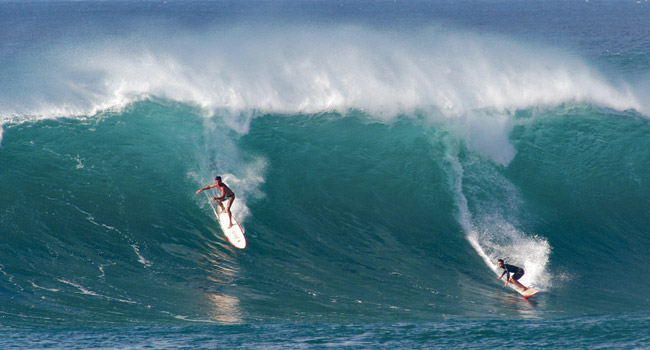New, Enhanced Big-surf Warnings
The start of the winter surf season is always an exciting time for big-wave surfers and curious wave-watchers. But for those who risk their lives to keep beachgoers alive, the winter surf season can be a time of magnificent stress.
“While our lifeguards do everything within their power to protect beachgoers, there really is no substitute for folks who understand ocean hazards before they enter the water,” says Jim Howe, operations director for Oahu Ocean Safety. “Messaging is just so important.”
To ensure millions of beachgoers receive the right message, the Ocean Safety and Lifeguard Services Division of the City and County of Honolulu and NOAA’s National Weather Service recently announced new high-surf safety messages that will be used during big-wave episodes.
As of Jan. 3, “impact and call-to-action messages” will be part of the high-surf warning and advisory messages. Each message will classify the overall threat as one of the following: extreme, very high, high or moderate. Along with the new labels, the new messages will display enhanced information explaining the significant threats that should be expected. For example, if waves were in the 35- to 44-foot range, the message would be labeled very high.
“This would mean expect water surging and sweeping across beaches, coastal benches and lava flows, creating the potential for impacts to coastal properties and infrastructure, including roadways,” says Mike Cantin of the National Weather Service.
“Also, powerful longshore and rip currents will be present on most beaches. Large breaking waves and strong currents may impact harbor entrances and channels, causing challenging boat handling.”
Cantin says the call to action would be “only high experience persons should enter the water and inexperienced people should remain off beaches and adjacent beachfront areas. Anyone entering the water could face significant injury or death.”
The new enhanced messages were designed to increase awareness of the dangers associated with Hawaii’s seasonal high surf. Over the past two years, officials from the National Weather Service forecast office in Honolulu and Ocean Safety officials from around the state brainstormed ways to best express the dangers of the ocean. The messages are a product of some of Hawaii’s finest minds and lifesavers coming together to reach a common goal: Save lives.
“We realized that the wording in our high-surf advisory and warning products did not adequately explain the threats associated with high surf,” says Cantin. “Our goal in updating the wording is to better communicate the hazards so that beachgoers will have better information before they head out.”
According to state data, more than 17.5 million people visit Oahu beaches every year, and many are lured to areas where high surf, dangerous shore break and strong currents pose potential hazards, and at times can be deadly.
“Many beachgoers head out to locations away from beaches where lifeguards are located,” says Cantin. “The information they receive from our hazard products and their experience may be the only information they have to make safe decisions.”
Lifeguards certainly do their part to keep us safe at 33 beaches on Oahu and 10 on Kauai. Each year Honolulu’s 200 lifeguards make more than 1,100 rescues at guarded beaches and an estimated 227,000 preventative actions.
But despite their safety record, our well-trained lifeguards cannot be everywhere. That is why it’s vitally important that all beachgoers, including local residents, take responsibility to educate themselves about their surrounding conditions and understand the power of the ocean.
“The main message we’re trying to get across is to know before your go,” says Cantin. “We’d like folks to understand that safety should be paramount on their minds when they head to the ocean, and if they get the feeling that conditions are too dangerous for them, they probably are.”






